When someone types in a query into a search engine, they hope to find the answer to their question. However, many people don’t realize behind every search engine query is a searcher with specific intent.
Creating content without understanding the searcher’s intent is a wasted opportunity; this can help you better target your content and improve your chances of ranking higher on the Search Engine Results Page (SERP). This guide will discuss search intent and how to identify it for yourself.
What is Search Intent?
Search intent, also known as user intent, is the reason why a person performs a search.
Search intent is the what, why and how of a searcher’s query. It is what the person is looking for, why they are looking for it and how they want to find it.
For example, someone may search for “best laptops under $500” because they need to purchase a laptop that meets their budget and criteria. The intent behind this query is clear – the searcher is looking to buy a laptop.
Other search queries, such as “how to make a website”, may have different intents. The searcher could be looking for information on how to create a website.
Why Does Search Intent Matter?
Is search intent important?
The answer to this is definitely Yes!
Knowing a searcher’s intent is important because it can help you determine what type of content to create. If you can match your content to the searcher’s intent, you are more likely to rank higher in the SERP.
Here are other benefits for search intent:
- Drive more traffic to your website.
- Increase conversions.
- Improve the user experience on your site.
Types of Search Intent
There are many different types of search intent, each with its unique purpose.
In this guide, we will discuss the four most common types of search intent:
Navigational
Navigational search intent is when a person looks for a specific website or online resource. They may know the website’s name they are looking for or looking for a particular topic or product.
Example :
If someone searches for “Facebook,” they look to navigate the Facebook website.
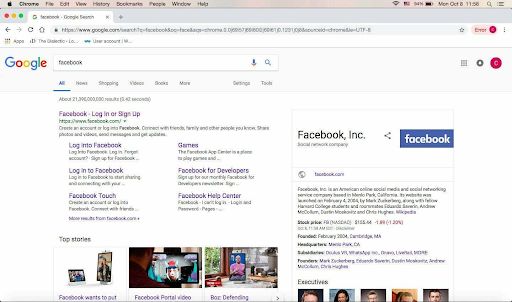
If someone searches for “Nike shoes,” they are looking to navigate to a website where they can purchase Nike shoes.
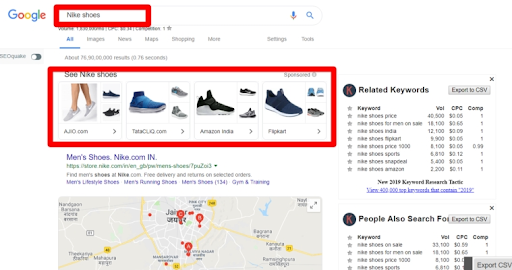
Navigational keywords are looking for a specific site and are not looking to explore other options.
Informational
Informational intent is when a person looks for information on a specific topic. They may be looking for a definition, an overview, or more detailed information, specific facts or statistics.
Informational intent keywords usually start with “what”, “how”, and “why”.
Example :
If someone searches for “what is SEO,” they are looking for an informational article that will give them a basic overview of SEO.
If someone searches for “how many countries are in the EU,” they are looking for a specific piece of information.
Informational type of content is the most common type of search intent.
Transactional
Transactional intent is when a person is looking to buy something online. They might be looking for a specific product or service or comparing prices and options.
Transactional search intent contains keywords such as “buy” or “book hotels”. These transactional queries are typically made when the searcher is ready to make a purchase.
Example :
If someone searches for “buy iPhone,” they are looking to purchase an iPhone.
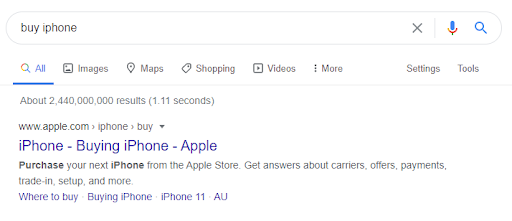
If someone searches for “hotels in Paris,” they are looking to find a hotel in Paris to book for their stay.
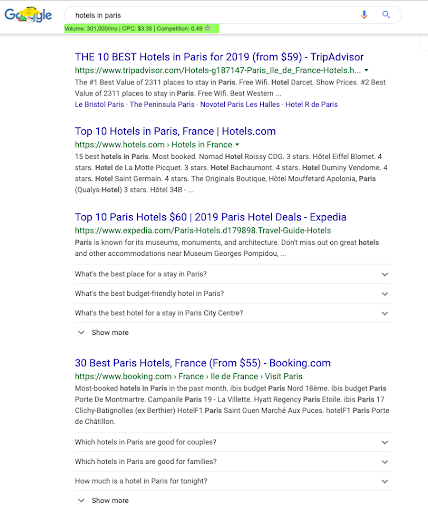
If you run an e-commerce site, your keyword research should focus primarily on search terms with transactional intent.
Commercial
Commercial intent is when a person wants to purchase, but they may not be ready to buy yet. They may compare prices, look for coupons or deals, or read reviews.
This type of search intent may contain words like “best” or “vs”.
Example :
If someone searches for “best TVs under $500,” they are looking to buy a TV, but they want to find the best option under $500.
If someone searches for “Hilton Honors points,” they may be trying to figure out how many points they need to book a hotel room or how to earn more points.

Remember these types of search intents when doing keyword research. Sometimes you might be able to identify your keyword’s intent by simply thinking like a searcher.
Try to think of a keyword and see if you can identify the keyword’s search intent. Guess if it has informational intent, transactional intent, or a navigational search intent before checking it through the SERPs.
Here are some of the modifiers you can use for each Search Intent:
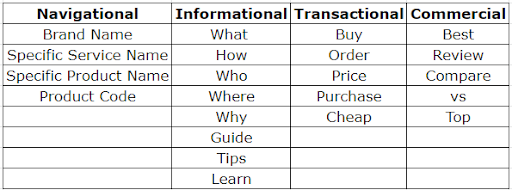
How to Determine User Intent?
Determining user intent is not always easy, and it often takes some trial and error. Luckily, you can use a few methods to help you determine user intent.
There are a few different ways to determine the search intent of a particular query:
Look at the SERP
One way is to look at the SERP (Search Engines Results Page) when you do a Google search. This can give you an idea of what searchers are looking for when they enter that query.
Review the SERP Result
Another way is to look at the types of results displayed in the google search results or any other search engine’s search result.
If you see mostly articles and blog posts, the searcher is probably looking for information. If you see mostly product listings, they are probably looking to buy something.
You can open the top articles and review their content to understand better what type of page they are and what they discuss inside the article.
Compare the Search Intent to Other Similar Keywords
You can also try different searches and compare the results to get an idea of the search intent.
Example:
Suppose you search for “pizza delivery” and see results for pizza places, apps, and articles about pizza delivery. In that case, this shows that people are looking for a way to get pizza delivered to their location.
Use Keyword Research Tools
Another way to identify searcher intent is to use keyword research tools. These tools can help you understand what people are searching for and how those searches can be categorized.
Review Competitor Sites
Finally, you can look at the competition. If you are trying to rank for a particular keyword, look at the other websites that are already ranking for that keyword. By reviewing your competitor’s keywords, you will understand what type of content they produced.
3 C’s of Search Intent
Now that we’ve gone over the different types of search intent let’s talk about the three C’s of search intent.
Content
Your content needs to be relevant to the keyword you are targeting. If you target a keyword with informational intent, your content requires to provide information on that topic.
If you target a keyword with transactional intent, your content needs to offer a product or service that meets the searcher’s needs.
Your content also needs to be well-written and free of errors. No one wants to read an article that is full of grammatical errors.
Conversion
Your content needs to be effective in converting searchers into customers or leads. If you are selling a product, your content needs to be persuasive enough to get the searcher to make a purchase.
If you are looking to generate leads, your content needs to be compelling enough to get the searcher to fill out a form.
Your content also needs to be mobile-friendly and easy to navigate. If your website is not mobile-friendly, you will lose many potential customers.
Context
Your content needs to be relevant to the searcher’s context, which means appropriate to the time, location, and device that the searcher is using.
Example:
If someone is searching for “restaurants near me,” they are likely looking for a list of restaurants that are close to their current location.
If someone is searching for the “best laptops for students,” they may be looking for a list of laptops that are best suited for students.
Keep the three C’s of search intent in mind when creating your content. If you can create relevant, persuasive, and mobile-friendly content, you will be well on your way to ranking higher in the search engines.
How to Optimize for Search Intent
Now it’s time to learn how to optimize your content based on the search intent.
Optimizing your article may not be as complicated as you think. You just need to check you are creating content for the right keyword.
Here are a few tips:
Categorize your keywords according to the user intent.
If you already have a list of target keywords, review the keyword intent by checking through the SERP. Scan the search results and identify the search intent for each keyword.
You can also use keyword research tools to help you understand the searcher’s intent.
Write content based on the search intent.
If you want your website to rank higher in the search engines, you need to make sure that you are writing content based on the searcher’s intent. Keep in mind that it’s important to optimize for search intent.
Provide informational content for informational keywords and navigational content for navigational intent keywords.
For informational queries, you want to ensure that your content is high-quality and provides the searcher with the information they are looking for and updated content.
Include people who also asked questions in your content.
If you want to give your website the best chance of ranking for a particular keyword, you should include people who also asked questions in your content.
It will help show Google that your content is relevant to the searcher’s query. Google will surely rank your content if they see that it matches your audience’s search intent.
You can find them in the google search results if the search intent is an informational search intent type.
Conclusion
Creating content that meets a searcher’s intent can be difficult. Still, it is important to fully understand the search intent before you start optimizing the page content and before doing further keyword research so you will be able to provide only relevant and high-quality content.
Ignoring search intent will make it hard for you to achieve SEO success on your website.
Once you have identified the search intent of each of your keywords, create content that will satisfy user intents. Now that you know what search intent is and how to determine it, you can start using it to improve your Search Engine Optimization (SEO) Strategy. If you have any questions, feel free to leave a comment below!




